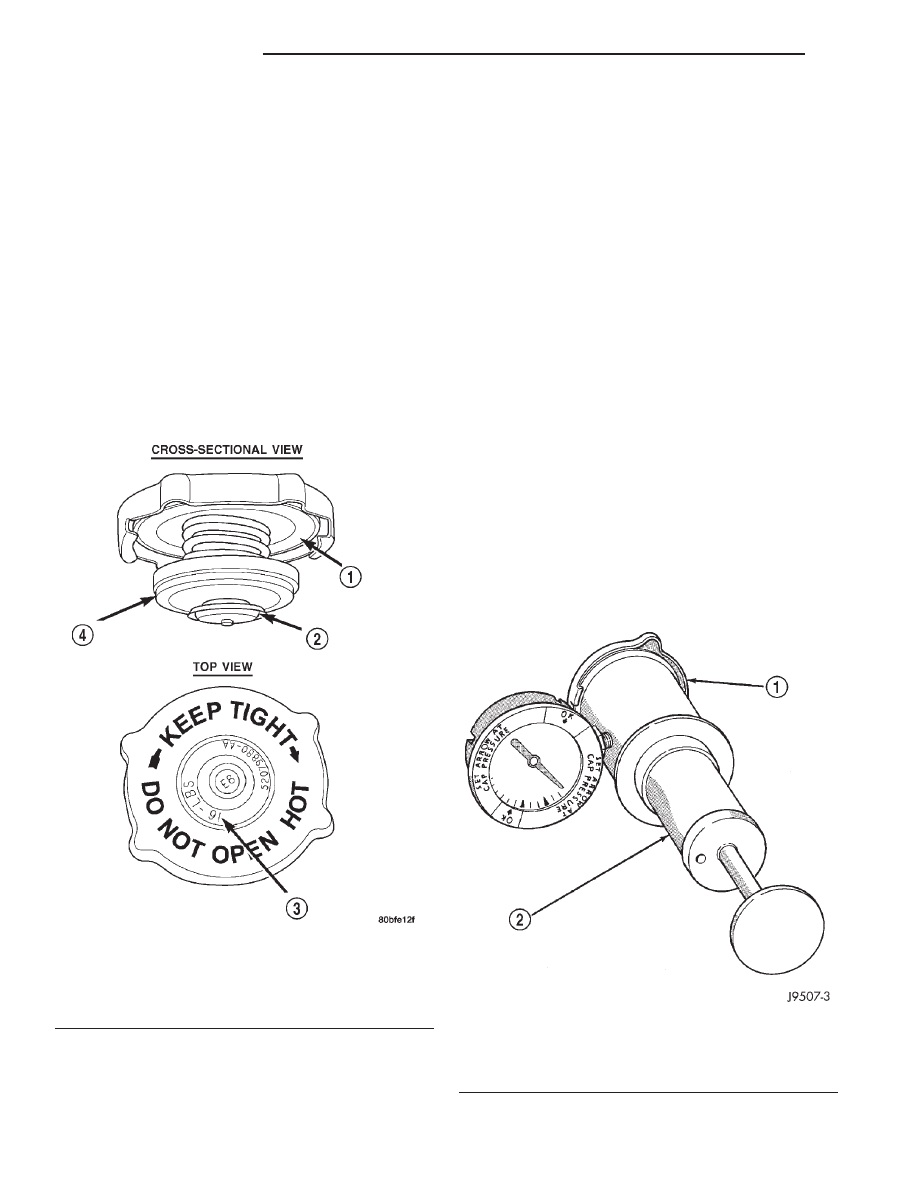Jeep XJ. Manual - part 68

RADIATOR CAP-TO-FILLER NECK SEAL—
PRESSURE RELIEF CHECK
With radiator cap installed on filler neck, remove
coolant reserve/ overflow tank hose from nipple on
filler neck. Connect a hand operated vacuum pump
to nipple. Operate pump until a reading of 47-to-61
kPa (14- to-18 in. Hg) appears on gauge. If the read-
ing stays steady, or drops slightly and then remains
steady, the pressure valve seal is good. Replace radi-
ator cap if reading does not hold.
WARNING: THE WARNING WORDS -DO NOT OPEN
HOT- ON THE RADIATOR PRESSURE CAP (Fig. 19)
ARE A SAFETY PRECAUTION. WHEN HOT, PRES-
SURE BUILDS UP IN COOLING SYSTEM. TO PRE-
VENT SCALDING OR INJURY, THE RADIATOR CAP
SHOULD NOT BE REMOVED WHILE THE SYSTEM
IS HOT AND/OR UNDER PRESSURE.
There is no need to remove the radiator cap
except for the following purposes:
(1) To check and adjust antifreeze freeze point.
(2) To refill system with new antifreeze.
(3) For conducting service procedures.
(4) When checking for vacuum leaks.
WARNING: IF VEHICLE HAS BEEN RUN RECENTLY,
WAIT AT LEAST 15 MINUTES BEFORE REMOVING
RADIATOR CAP. WITH A RAG, SQUEEZE RADIATOR
UPPER HOSE TO CHECK IF SYSTEM IS UNDER
PRESSURE. PLACE A RAG OVER THE CAP AND
WITHOUT
PUSHING
DOWN,
ROTATE
CAP
COUNTER-CLOCKWISE
TO
THE
FIRST
STOP.
ALLOW FLUID TO ESCAPE THROUGH OVERFLOW
HOSE
INTO
COOLANT
RESERVE/OVERFLOW
TANK. SQUEEZE RADIATOR UPPER HOSE TO
DETERMINE
WHEN
PRESSURE
HAS
BEEN
RELEASED. WHEN COOLANT AND STEAM STOP
BEING PUSHED INTO TANK AND SYSTEM PRES-
SURE DROPS, REMOVE RADIATOR CAP COM-
PLETELY.
RADIATOR CAP—PRESSURE TESTING
Remove cap from radiator. Be sure that sealing
surfaces are clean. Moisten rubber gasket with water
and install the cap on pressure tester (tool 7700 or
an equivalent) (Fig. 20).
Fig. 19 Radiator Pressure Cap
1 – FILLER NECK SEAL
2 – VACUUM VENT VALVE
3 – PRESSURE RATING
4 – PRESSURE VALVE
Fig. 20 Pressure Testing Radiator Pressure
Cap—Typical
1 – PRESSURE CAP
2 – TYPICAL COOLING SYSTEM PRESSURE TESTER
7 - 20
COOLING SYSTEM
XJ
DIAGNOSIS AND TESTING (Continued)